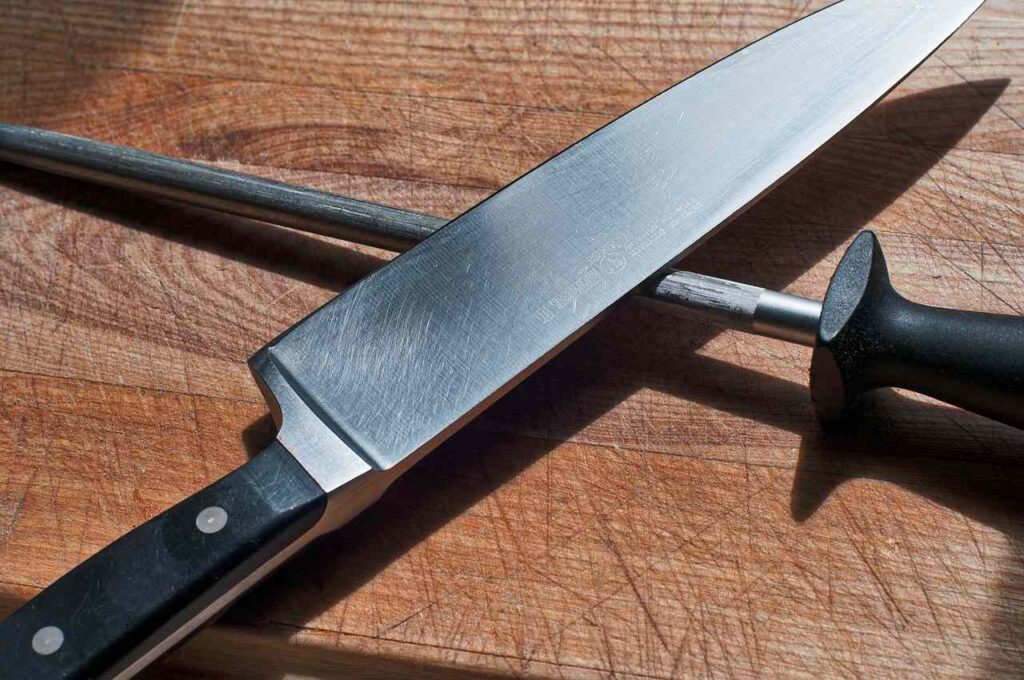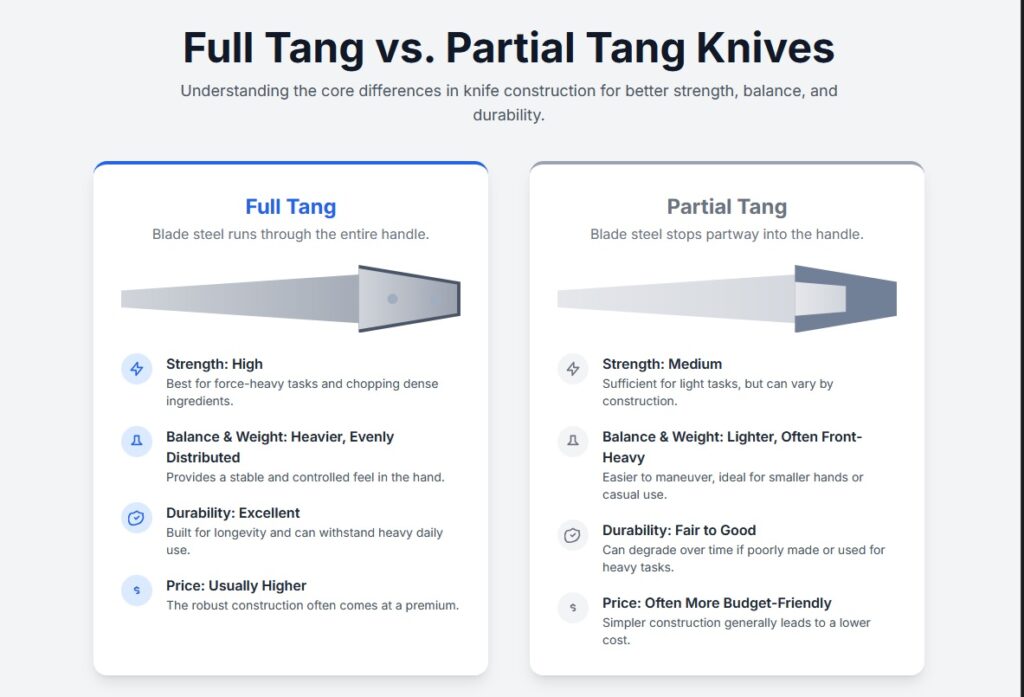Published on August 5, 2025 by Filip
Last updated on August 12, 2025

In knife design, the tang is the part of the blade that extends into the handle.
There are two main types:
- Full Tang: The steel runs the entire length of the handle. It’s usually visible along the top and bottom edges and gives the knife a heavier and more balanced feel.
- Partial Tang: The steel only extends partway into the handle. It’s hidden inside and may vary in length, depending on the knife.
The tang affects a knife’s balance, durability, and weight, but a longer tang doesn’t automatically equal better performance. What matters more is the knife’s overall construction quality. That includes its steel, handle material, and how the two are joined together.
TL;DR: Full Tang vs Partial Tang
| Feature | Full Tang | Partial Tang |
|---|---|---|
| Steel Length | Runs full handle length | Stops partway inside handle |
| Visibility | Usually exposed between handle slabs | Hidden inside the handle |
| Strength | High – less likely to break | Medium – depends on construction |
| Weight | Heavier | Lighter |
| Balance | Better for heavy chopping tasks | Better for lighter slicing tasks |
| Cost | Usually more expensive | More budget-friendly |
Is Full Tang Always Better?
Not necessarily. While full tang knives are known for strength and balance, a well-made partial tang knife can still be extremely reliable – especially when molded into the handle, like the Victorinox Fibrox Pro. Poorly made full tang knives with bad steel and cheap handles are still bad knives. As you can see, the knife’s tang is only one part of the equation.
“Full tang is a durability feature – not a guarantee of quality.”
What Is a Full Tang Knife?
A full tang knife’s blade steel extends throughout its entire handle, from its tip to its rear-end. You can typically see the steel between two handle slabs which are often secured with rivets.
This design improves your knife’s strength and control, especially during heavy-duty chopping of meat and root vegetables.
Advantages of Full Tang Knives
These are the main advantages of full tang knives:
| Benefit | Why It Matters |
|---|---|
| Stronger Build | Less likely to snap or loosen under pressure — the blade and handle are one solid piece. |
| Improved Balance | Even weight distribution makes the knife feel stable and predictable in motion. |
| Better for Heavy Cuts | Ideal for dense foods like squash, potatoes, or raw meat. |
| Durability | Withstands years of use without wiggling or breaking. |
A well-made full tang knife will often feel like an extension of your hand. It’s the go-to choice for professional chefs and butchers, for example – and any home cook would benefit massively from a full tang, regardless of experience. When I first laid my hands on one, I immediately felt like a pro, even though I had no idea what I was doing and hadn’t mastered knife basics yet.
Disadvantages of Full Tang Knives
Although full-tang knives are mostly about the pros, they do come with some drawbacks as well, for example:
| Drawback | What to Watch Out For |
|---|---|
| Heavier Feel | Not ideal for people with wrist issues or those who prefer lightweight knives. |
| Higher Cost | Full tang construction usually comes at a slightly higher price. |
| Requires Maintenance | Some full tang knives have wooden handles that aren’t dishwasher safe and can swell or crack if neglected. |
It’s true that full tang knives are designed to withstand heavy-duty work. However, they’re not always the most beginner-friendly option.
Best Use Cases for Full Tang Knives
A full tang construction will add durability and balance, which makes a real difference in some situations, such as:
- Prepping Large Meals – extended chopping sessions benefit from a knife that feels stable and dependable. Full tang designs reduce hand strain by distributing weight more evenly across the handle and blade.
- Cutting Tough Ingredients – full tang knives shine with denser foods like root vegetables, raw meat, squash, or anything that requires force. The added structural integrity means the blade is unlikely to flex under the pressure.
- When You Prefer a Sturdy, Weighted Feel – many cooks value the tactile feedback that is provided by a heavier blade. Full tang knives tend to feel more secure and grounded in the hand, especially if you have larger lands or more knife control experience.
- As a Long-Term Kitchen Investment – if you’re looking for a knife that will last for years with proper care, full tang models are a safe bet. It’s very unlikely to break over time, especially compared to different construction styles.
Good to Know for Full Tang Chef Knives
Full tang is often marketed as a premium feature, but it’s not a guarantee of quality on its own. What actually matters is how well the entire knife is made.
- Full tang doesn’t automatically mean “better.” It simply indicates potential. The rest comes down to steel hardness, handle materials, edge geometry, and build integrity.
- A low-quality full tang knife can still underperform if it uses cheap steel, has a poorly fitted or glued handle, or lacks edge retention.
- A well-made full tang knife, on the other hand, offers a great balance of strength, comfort, and longevity, particularly when its paired with high-quality steel and a comfortable grip.
What Is a Partial Tang Knife?
A partial tang knife has a blade where the steel extends only partway into the handle. Unlike full tang knives, the tang is usually hidden inside and varies in length depending on the manufacturer and design.
This doesn’t mean the knife is inherently weak. In fact, many highly rated kitchen knives use partial tang construction successfully. The key is how well the blade is joined to the handle, and whether the materials can handle regular use without loosening or breaking down over time.
Advantages of Partial Tang Knives
These are the primary advantages of partial tang knives:
| Benefit | Why It Matters |
|---|---|
| Lighter Weight | Easier to control, especially for small hands or quick slicing tasks. |
| Budget-Friendly | Typically more affordable than full tang knives, even from reputable brands. |
| Less Fatiguing | Ideal for shorter sessions or lighter prep work – you won’t feel the weight dragging on your wrist. |
| Streamlined Design | Partial tangs allow for sleek or molded handles, which some cooks find more ergonomic. |
Good partial tang knives are especially useful for new cooks, casual prep, or anyone who wants a blade that feels light and easy to work with.
Disadvantages of Partial Tang Knives
The key disadvantages of partial tang knives include:
| Limitation | What to Consider |
|---|---|
| Potential Weak Points | If poorly made, the blade may loosen or separate from the handle over time. |
| Lower Structural Strength | Not ideal for heavy chopping, frozen foods, or anything requiring torque. |
| Less Balanced Feel | May feel front-heavy, especially on longer blades. |
That said, many popular models – like the Victorinox Fibrox Pro – use reinforced molded handles around a partial tang to compensate for structural limitations. In those cases, performance is excellent and durability is proven in real kitchens.
Best Use Cases for Partial Tang Knives
Partial tangs make sense when you don’t need maximum force or durability, rather just reliability and ease of use.
- Everyday light meal prep
- Chopping herbs, soft vegetables, or boneless proteins
- For younger cooks or beginners learning proper grip
- As a backup or secondary knife in your setup
If you mostly prep salads, sandwiches, or quick dinners, there’s no real downside, as long as the knife is from a brand known for decent steel and construction.
Good to Know for Partial Tang Chef Knives
- Partial tang knives aren’t automatically “cheap.” Many brands balance steel hardness, molded handles, and precision grinding to make them high-performing tools at a lower price point.
- Avoid unknown or no-name knives with glued or plastic handles – these are the ones most likely to crack or wobble.
- Use context to guide your purchase: If you’re not carving bone-in meat or prepping massive batches, a lightweight partial tang blade might feel smoother, faster, and less fatiguing.
Full Tang vs Partial Tang: Which Should You Choose?
The best choice depends entirely on how – and how often – you cook. Both tang types can serve you well if the knife is built properly. What matters most is task fit, not just construction style.
Use this comparison to guide your pick:
Full Tang vs Partial Tang Summary
This image best illustrates the key strength and differences between full tang and partial tang kitchen chef knives:

Also outlined in my table:
| Feature | Full Tang | Partial Tang |
|---|---|---|
| Steel Extension | Blade steel runs through entire handle | Blade steel stops partway into handle |
| Strength | High – best for force-heavy tasks | Medium – depends on construction |
| Weight | Heavier, more stable | Lighter, easier to maneuver |
| Balance | Evenly distributed | Often front-heavy |
| Durability | Excellent with quality build | Can degrade if poorly made |
| Ideal For | Daily prep, dense ingredients, longevity | Light tasks, casual use, smaller hands |
| Price Range | Usually higher | Often more budget-friendly |
📌 Expert Takeaway
“Full tang knives offer maximum strength and stability, but partial tang knives can perform just as well in everyday cooking – if they’re built with quality materials.”
If you want a knife that will handle anything from raw squash to tough meats and vegetables, then go with a full tang knife.
If you’re after a lighter tool for routine slicing or prepping a quick dinner, a well-designed partial tang knife will be more than capable.
